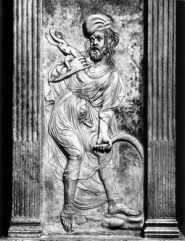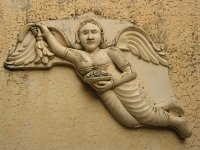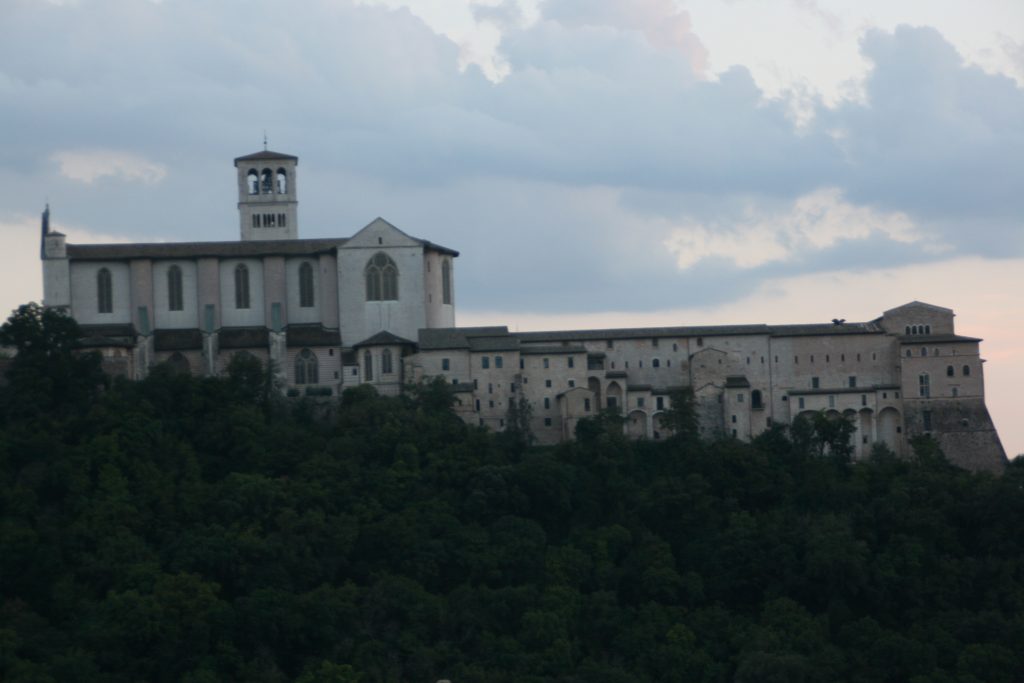The holy days of Saturn
It seems that our custom to exchange gifts during Christmas comes from some ancient traditions practiced at the Saturnalia, one of the most popular holidays in the Roman calendar.
The Saturnalia festival, that in later centuries would change into the Brumalia festival (from bruma, winter solstice), represented an occasion for visiting friends and presenting gifts, particularly wax candles and small earthenware figurines, named sigillaria (Macrobius, Saturnali I, I, 10.24).

The Saturnalia consisted of banquets, dances, orgies and excesses of all kinds. Even gambling, banned in the rest of the year, was tolerated during the celebration. Pliny the Younger withdrew to a secluded house to study in peace during the festival’s days (Epistles, II, 17, 24).
Originally the celebrations took place on only one day: the fourteenth day before the Kalends of January (December 19), but during the imperial age they lasted seven days, from December 17 to 23. In these days all the rules were inverted, so that even the slaves were treated as equals: they could wear clothing of their masters and could eat at their tables in remembrance of the legendary “golden age”, when people lived peacefully, without discrimination between freemen and slaves.
We know that the term Saturnalia derives from Saturn, the italic god identified with the greek Kronos. During the Saturnalia, inside the God’s temple in Rome (situated in the Roman Forum) the feet of his ivory cult statue were symbolically freed from the woollen bonds that tied them up for the rest of the year, to represent the liberation of the god Saturn and the return to the mythical ancient “Golden Age”.
As Seneca mentions (Apocol. 8.2), on the first day of Saturnalia was elected a symbolic figure that would reign in the chaos of the festival. Also known by the name of rex saturnaliorum, this symbolic king may have represented the same god Saturn.
Upon conclusion of the festivities, the fate of the rex saturnaliorum was to be put to death, through a symbolic killing.
Some features of this ancient ritual perhaps still survive today in some regions of Italy, where it is still alive the tradition of setting fire to a puppet during the New Year’s Eve. In some places the tradition survives to represent a character burlesque dancing among the crackling of firecrackers in the village square.
This leads us to ask why the Roman Saturnalia were held at the end of December rather then the end of February – shortly before the arrival of spring – when the Romans used to celebrate the New Year. The fact is that the ancient calendar of Romolo was composed of only ten months, as evidenced by the name of the last month: December.
In this calendar January and February were a period of transition, waiting for the new year and the renewal of the cosmos.
After the reform of Numa, who introduced the two missing months in his new calendar, the period of transition and renewal (focused on the days before the winter solstice, from 21st to 24th of December) represents an “apparent death” of the sun, preceding his rising again, higher in the sky, in the following days.ù

Interesting is to discover that there are some similar characteristics between the god Saturn and the Vedic figure of Satyavrata. The Hindu tradition says that Lord Vishnu appeared to the king Satyavrata, in the form of a giant fish, to announce to him a cosmic deluge.
The Lord ordered Satyavrata to build a boat to save seeds, plants and animals required for creating the next world. In the Hindu myth the figure of Satyavrata is similar to Noah.
According to René Guénon Satyavrata may represent – like the god Saturn – the manifestation of a deity who creates and recreates the cosmos continuously.
Vishnu appeared to Satyavrata in a transitional period at the end of the cosmic cycle preceding the present one, while Saturn’s role of renewer of the cosmos is confirmed by the Saturnalia, celebrated as a week of transition and renewal, in which everything is allowed.
No less interesting is to note that the root “sat” (which in Sanskrit means: the One) is common to both deities.
Antonella Bazzoli – December 2008, updated December 2013



